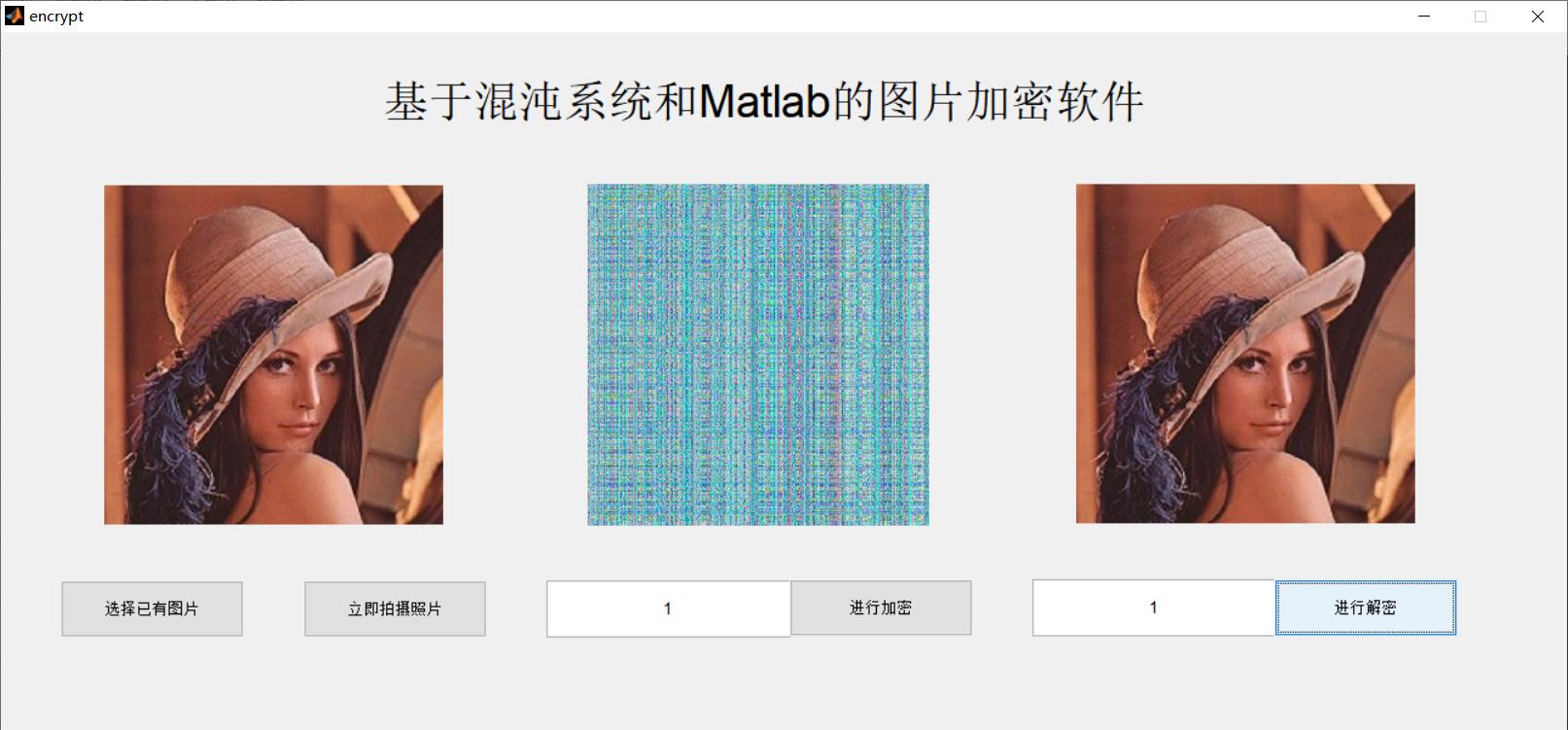图像加密基于混沌系统的图像加密解密matlab源码含GUI
Posted Matlab走起
tags:
篇首语:本文由小常识网(cha138.com)小编为大家整理,主要介绍了图像加密基于混沌系统的图像加密解密matlab源码含GUI相关的知识,希望对你有一定的参考价值。
Logistic混沌置乱,先不说有多复杂,其实很简单。
Logistic函数是源于一个人口统计的动力学系统,其系统方程形式如下:
X(k+1) = u * X(k) * [1 - X(k)],(k=0,1,…,n)
先不用管这个方程是怎么得出来的,觉得不舒服的话自己百度去。可以看出这个方程是非线性的,迭代的形式。要使用的话,我们需要知道两个东西:
① 初值:X(0)
② 参数:u
为什么这个方程可以称作混沌呢?它什么时候是一个混沌系统呢?这个也是有条件的:
① 0 < X(0) < 1
② 3.5699456... < u <=4
当满足上述两个条件时,Logistic函数工作于混沌状态。这两个条件是怎么来的请百度,我们这里只说算法和实现。什么是混沌状态:顾名思义就是一种无序的、不可预测的、混乱的、摸不到头、摸不到尾的状态。混沌状态时会出现什么现象,我们以下面的参数为例:
① X(0) = 0.1
② u = 4
当迭代n次后,我们就得到了X(1)、X(2)、…,X(n)这么n个值。那么这就是一个混沌序列,是一维的暂且称作序列A,也就是我们想要得到的序列,在MATLAB中,可以看出X(i)(i=1,2,…,n)的取值是在(0,1)之间的——这是一个很好地特性,就像图像灰度值是在(0,255)之间一样。那么我们把这个一维序列归一化到(0,255)之间得到序列B。
再来看加密过程。对于一幅M*N大小的图像(暂且称为Picture),我们需要产生一个同样大小的矩阵来对其进行加密。如此说来,只需要迭代M*N次得到序列A,再转成序列B,此时序列B是一维的,将其转化成M*N的二维矩阵(暂且称为Fuck)。因此,用Fuck与Picutre进行异或,便可得到一幅新的图像,称作Rod,如此便完成了一次图像加密,加密后的图像为Rod。
Rod=Picture⊕Fuck(⊕表示异或)
这样我们手中的秘钥是:u,X(0)
此种加密方式称作序列加密,可以看出这种加密方式改变了下像素的灰度(直方图变了),没有改变位置。解密同样道理:Picture = Rod⊕Fuck。
function varargout = encrypt(varargin)
% ENCRYPT MATLAB code for encrypt.fig
% ENCRYPT, by itself, creates a new ENCRYPT or raises the existing
% singleton*.
%
% H = ENCRYPT returns the handle to a new ENCRYPT or the handle to
% the existing singleton*.
%
% ENCRYPT('CALLBACK',hObject,eventData,handles,...) calls the local
% function named CALLBACK in ENCRYPT.M with the given input arguments.
%
% ENCRYPT('Property','Value',...) creates a new ENCRYPT or raises the
% existing singleton*. Starting from the left, property value pairs are
% applied to the GUI before encrypt_OpeningFcn gets called. An
% unrecognized property name or invalid value makes property application
% stop. All inputs are passed to encrypt_OpeningFcn via varargin.
%
% *See GUI Options on GUIDE's Tools menu. Choose "GUI allows only one
% instance to run (singleton)".
%
% See also: GUIDE, GUIDATA, GUIHANDLES
% Edit the above text to modify the response to help encrypt
% Last Modified by GUIDE v2.5 24-Dec-2019 21:56:19
% Begin initialization code - DO NOT EDIT
gui_Singleton = 1;
gui_State = struct('gui_Name', mfilename, ...
'gui_Singleton', gui_Singleton, ...
'gui_OpeningFcn', @encrypt_OpeningFcn, ...
'gui_OutputFcn', @encrypt_OutputFcn, ...
'gui_LayoutFcn', [] , ...
'gui_Callback', []);
if nargin && ischar(varargin{1})
gui_State.gui_Callback = str2func(varargin{1});
end
if nargout
[varargout{1:nargout}] = gui_mainfcn(gui_State, varargin{:});
else
gui_mainfcn(gui_State, varargin{:});
end
% End initialization code - DO NOT EDIT
% --- Executes just before encrypt is made visible.
function encrypt_OpeningFcn(hObject, eventdata, handles, varargin)
% This function has no output args, see OutputFcn.
% hObject handle to figure
% eventdata reserved - to be defined in a future version of MATLAB
% handles structure with handles and user data (see GUIDATA)
% varargin command line arguments to encrypt (see VARARGIN)
% Choose default command line output for encrypt
handles.output = hObject;
% Update handles structure
guidata(hObject, handles);
% UIWAIT makes encrypt wait for user response (see UIRESUME)
% uiwait(handles.figure1);
% --- Outputs from this function are returned to the command line.
function varargout = encrypt_OutputFcn(hObject, eventdata, handles)
% varargout cell array for returning output args (see VARARGOUT);
% hObject handle to figure
% eventdata reserved - to be defined in a future version of MATLAB
% handles structure with handles and user data (see GUIDATA)
% Get default command line output from handles structure
varargout{1} = handles.output;
% --- Executes on button press in pushbutton1.
function pushbutton1_Callback(hObject, eventdata, handles)
% hObject handle to pushbutton1 (see GCBO)
% eventdata reserved - to be defined in a future version of MATLAB
% handles structure with handles and user data (see GUIDATA)
[filename,filepath] = uigetfile({'*.bmp;*.jpg;*.png;*.jpeg;*.tif','文件类型 (*.bmp,*.jpg,*.png,*.jpeg,*.tif)';'*.*', '所有文件(*.*)'},'Pick an image');
file = strcat(filepath,filename);
im = imread(file);
axes(handles.axes1);
imshow(im);
imwrite(im,'snap.bmp');
% --- Executes on button press in pushbutton2.
function pushbutton2_Callback(hObject, eventdata, handles)
% hObject handle to pushbutton2 (see GCBO)
% eventdata reserved - to be defined in a future version of MATLAB
% handles structure with handles and user data (see GUIDATA)
obj = videoinput('winvideo',1,'YUY2_1280x720')%1280x720 160x120 176x144 320x240 352x288 640x480
% vidRes = get(obj, 'VideoResolution');
% nBands = get(obj, 'NumberOfBands');
% preview(obj);%getsnapshot(obj);
vidRes = get(obj, 'VideoResolution');
nBands = get(obj, 'NumberOfBands');
hImage = image( zeros(vidRes(2), vidRes(1), nBands),'parent',handles.axes1);
preview(obj, hImage);
frame = getsnapshot(obj);
frame = ycbcr2rgb(frame);
imwrite(frame,'snap.bmp','bmp');
pic = imread('snap.bmp');
axes(handles.axes1);
imshow(pic);
title(date,'color','r');
function edit1_Callback(hObject, eventdata, handles)
% hObject handle to edit1 (see GCBO)
% eventdata reserved - to be defined in a future version of MATLAB
% handles structure with handles and user data (see GUIDATA)
% Hints: get(hObject,'String') returns contents of edit1 as text
% str2double(get(hObject,'String')) returns contents of edit1 as a double
% input = str2num(get(hObject,'String'));%这里get后面要注意
% if(isempty(input))
% set(hObject,'String','0')
% end
guidata(hObject,handles)
% --- Executes during object creation, after setting all properties.
function edit1_CreateFcn(hObject, eventdata, handles)
% hObject handle to edit1 (see GCBO)
% eventdata reserved - to be defined in a future version of MATLAB
% handles empty - handles not created until after all CreateFcns called
% Hint: edit controls usually have a white background on Windows.
% See ISPC and COMPUTER.
if ispc && isequal(get(hObject,'BackgroundColor'), get(0,'defaultUicontrolBackgroundColor'))
set(hObject,'BackgroundColor','white');
end
% --- Executes on button press in pushbutton3.
function pushbutton3_Callback(hObject, eventdata, handles)
% hObject handle to pushbutton3 (see GCBO)
% eventdata reserved - to be defined in a future version of MATLAB
% handles structure with handles and user data (see GUIDATA)
a=imread('snap.bmp');
R=a(:,:,1); %取图像的R层像素
G=a(:,:,2); %取图像的G层像素
B=a(:,:,3); %取图像的B层像素
[M1,N1]=size(R);
[M2,N2]=size(G);
[M3,N3]=size(B);
h=0.01; %混沌序列初始化
x=zeros(1,40001);x(1)= str2num(get(handles.edit1,'String'));
y=zeros(1,40001);y(1)=0;
z=zeros(1,40001);z(1)=0;
w=zeros(1,40001);w(1)=0;
v=zeros(1,40001);v(1)=0;
for n=1:40000 %产生混沌序列初始化,欧拉法
x(n+1)=x(n)+h*(3.5*(y(n)-x(n)-(-1.2+0.3*(w(n)*w(n)))*x(n)));
y(n+1)=y(n)+h*(2.1*y(n)-z(n)-0.2*(y(n)-x(n))-0.2*(1.2+7*abs(v(n)))*y(n));
z(n+1)=z(n)+h*(2.1*y(n)-z(n));
w(n+1)=w(n)+h*(x(n));
v(n+1)=v(n)+h*(y(n));
end
for n=1:40000 %对3个序列进行改进
x(n)=x(n)*1000000-round(x(n)*1000000);
y(n)=y(n)*1000000-round(y(n)*1000000);
z(n)=z(n)*1000000-round(z(n)*1000000);
w(n)=w(n)*1000000-round(w(n)*1000000);
v(n)=v(n)*1000000-round(v(n)*1000000);
end
% %对R通道进行加密
for j=1:N1 %用位异或法对像素进行置乱
aa=(uint8((M1*N1*(x(N1+j)+0.5))*ones(M1,1)));
g1(:,j)=bitxor(R(:,j),aa);
h1(:,j)=bitxor(g1(:,j),aa); %对像素置乱进行解密
end
for i=1:M1 %行置乱
t(1:N1)=y(1:N1);
[t1,index1]=sort(t(1:N1));
t1=flipud(t1);
g2(i,:)=g1(i,index1);
h2(i,index1)=g2(i,:);
end
for j=1:N1 %列置乱
t(1:M1)=z(1:M1);
[t1,index1]=sort(t(1:M1));
index1=flipud(index1);
g3(:,j)=g2(index1,j);
h3(index1,j)=g3(:,j);
end
% %对G通道进行加密
for j=1:N2 %用位异或法对像素进行置乱
bb=(uint8((M2*N2*(x(N2+j)+0.5))*ones(M2,1)));
j1(:,j)=bitxor(G(:,j),bb);
k1(:,j)=bitxor(j1(:,j),bb); %对像素置乱进行解密
end
for i=1:M2 %行置乱
t(1:N2)=x(1:N2);
[t2,index2]=sort(t(1:N2));
t2=flipud(t2);
j2(i,:)=j1(i,index2);
k2(i,index2)=j2(i,:);
end

完整代码添加QQ1575304183
以上是关于图像加密基于混沌系统的图像加密解密matlab源码含GUI的主要内容,如果未能解决你的问题,请参考以下文章